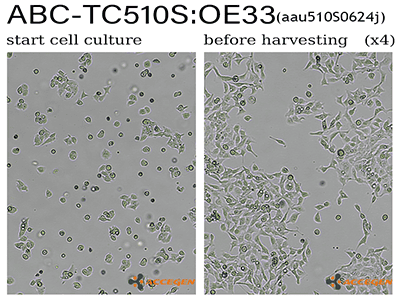Featured Products
Explore Products
- In-Stock Tumor Cell Lines
- Human Orbital Fibroblasts
- Human Microglia
- Human Pulmonary Alveolar Epithelial Cells
- Human Colonic Fibroblasts
- Human Type II Alveolar Epithelial Cells
- Human Valvular Interstitial Cells
- Human Thyroid Epithelial Cells
- C57BL/6 Mouse Dermal Fibroblasts
- Human Alveolar Macrophages
- Human Dermal Fibroblasts, Adult
- Human Lung Fibroblasts, Adult
- Human Retinal Muller Cells
- Human Articular Chondrocytes
- Human Retinal Pigment Epithelial Cells
- Human Pancreatic Islets of Langerhans Cells
- Human Kidney Podocyte Cells
- Human Renal Proximal Tubule Cells



 The OE33 cell line, also known as JROECL33, was established from a 73-year-old female patient with adenocarcinoma originating in the lower esophagus, specifically associated with Barrett’s metaplasia. The tumor was diagnosed as pathological stage IIA (UICC) and exhibited poor differentiation. OE33 cells continuously express HLA-A, -B, and -C antigens (MHC class I), along with ICAM-1. The introduction of interferon-gamma can induce the expression of HLA-DR (MHC class II) in these cells. They display epithelial cytokeratins such as CK7, CK8, CK18, and CK19, while CK17 is notably absent. Moreover, OE33 cells express EpCAM but lack desmin, endothel, GFAP, neurofilament, and vimentin. Notably, they possess tumorigenic potential when transplanted into nude mice.
The OE33 cell line, also known as JROECL33, was established from a 73-year-old female patient with adenocarcinoma originating in the lower esophagus, specifically associated with Barrett’s metaplasia. The tumor was diagnosed as pathological stage IIA (UICC) and exhibited poor differentiation. OE33 cells continuously express HLA-A, -B, and -C antigens (MHC class I), along with ICAM-1. The introduction of interferon-gamma can induce the expression of HLA-DR (MHC class II) in these cells. They display epithelial cytokeratins such as CK7, CK8, CK18, and CK19, while CK17 is notably absent. Moreover, OE33 cells express EpCAM but lack desmin, endothel, GFAP, neurofilament, and vimentin. Notably, they possess tumorigenic potential when transplanted into nude mice.
